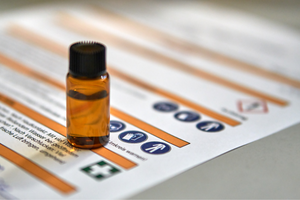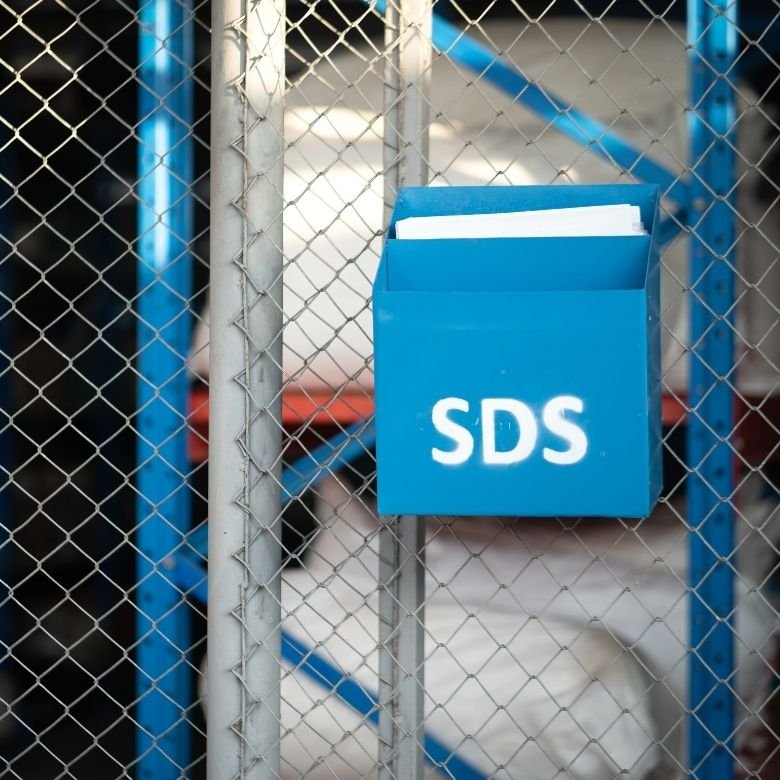A safety data sheet (SDS) is a document that provides comprehensive information on chemical substances/mixtures. For some chemicals, it is required by law (see below). The structure of the SDS and its contents are precisely defined by international regulations.

MSDS and SDS – what’s the difference?
With some simplification, it can be assumed that the MSDS (Material Safety Data Sheet) is the prototype for the SDS (Safety Data Sheet) currently used in the EU. Compared to the MSDS, the format of the SDS document and the way information is presented in it have been clarified and standardised through international regulations. Many sources still use the old term MSDS today (probably out of habit) when actually referring to the SDS. The SDS is the only legally acceptable form of document in the EU.
What regulations govern the content of the SDS?
In Poland, as in the entire EU, the obligation to prepare safety data sheets for substances/mixtures of concern results from Article 31 of the Regulation on the Registration, Evaluation, Authorisation and Restriction of Chemicals (REACH). The SDS format is defined in Annex II of the REACH Regulation. The first version of the REACH Regulation was drawn up in 2006, and subsequent amendments force suppliers to adapt their documents to the current regulations within the deadline provided by the amendment.
The REACH Regulation and the CLP Regulation have enabled the implementation of the GHS (Globally Harmonized System of Classification and Labelling of Chemicals) into European law, which has significantly improved communication in the world of chemicals.
Which products require an SDS?
REACH precisely defines which products must be issued with an SDS. These include, in particular, substances and mixtures of concern, i.e. substances and mixtures classified under the CLP Regulation but also substances that are persistent, bioaccumulative and toxic (PBT) or very persistent and very bioaccumulative (vPvB) or substances on the candidate list of substances subject to authorisation for any other reason.
There are cases of mixtures that are not classified in accordance with the CLP Regulation but require an SDS to be prepared or made available upon request. This applies to the situations defined in Article 31(3) and further clarified in the guidance issued by ECHA on the compilation of safety data sheets.

What must a safety data sheet contain?
The format of the SDS is strictly defined in Annex II of the REACH Regulation. The structure of the document cannot be modified. Each SDS consists of 16 sections, includes the date the document was prepared and updated, if applicable, as well as the revision number.
Individual SDS sections contain the following information:
- Identification of the substance/mixture, use of the product and identification of the company;
- Hazards of the substance/mixture, including classification and labelling in accordance with the CLP Regulation;
- Composition of the substance/mixture;
- First aid measures;
- Firefighting measures;
- Accidental release measures;
- Handling and storage;
- Control parameters and personal protective equipment;
- Physical and chemical properties of the product;
- Stability and reactivity;
- Toxicity to human health;
- Ecological information,;
- Disposal considerations;
- Transport;
- Legal provisions relating to the substance/mixture;
- Additional data.
None of the mandatory sections of the SDS can be left blank. However, if necessary, the unavailability of specific data may be indicated with a justification. The information in the safety data sheet must be presented in a clear and concise manner.
Where a chemical safety report (CSR) is required for a substance, exposure scenarios for the identified uses of the substance should be included in an attachment to the safety data sheet. Exposure scenarios describe the operational conditions and risk management measures that should be in place to control risks to human health and the environment.
Who prepares/provides the SDS?
It is the responsibility of the supplier of the substance/mixture for which the SDS is required to provide a safety data sheet. In practice, the document is prepared by qualified persons with extensive knowledge of the product itself, the associated hazards and the legal provisions. The task can be performed by company personnel or outsourced to independent experts or companies.
A safety data sheet should be provided to the recipient:
– no later than the date on which the substance/mixture is placed on the market;
– in written or electronic form;
– in the official language of the country where the product is placed on the market.

The importance of the safety data sheet in trade and industry
The introduction of the SDS was intended to reduce the hazards associated with the production, transportation, storage, and use of chemical substances and mixtures classified as hazardous to health or the environment. Its measurable outcome is to be primarily safety in the workplace. The SDS specifies the applications for which the substance/mixture may be used and what working conditions should be provided.
The main recipients of safety data sheets are persons who carry out professional activities related to the use of a given material. It is the employer’s responsibility to provide the information contained in the SDS in a format that enables risk management in the specific workplace. All employees who have physical contact with chemicals should be provided with access to the information contained in the safety data sheet. For hazardous substances, the absence of an SDS makes the work in question illegal and unauthorised.
Well prepared and reliable safety data sheets help to ensure appropriate working conditions with chemicals and to select appropriate health and environmental protection measures. Adapting chemical handling to the requirements described in the SDS prevents life-threatening accidents and environmental disasters, thus protecting the well-being of employees and company property.
The safety data sheet should be duly consulted to verify the company’s safety conditions and measures, e.g. firefighting equipment. In the event of a medical emergency, it can also enhance the work of physicians by providing necessary information about the risks.
Requiring and using safety data sheets is therefore in the interest of any company that uses chemical substances and mixtures identified as hazardous in its operations. Also read about hazardous chemical labels.
